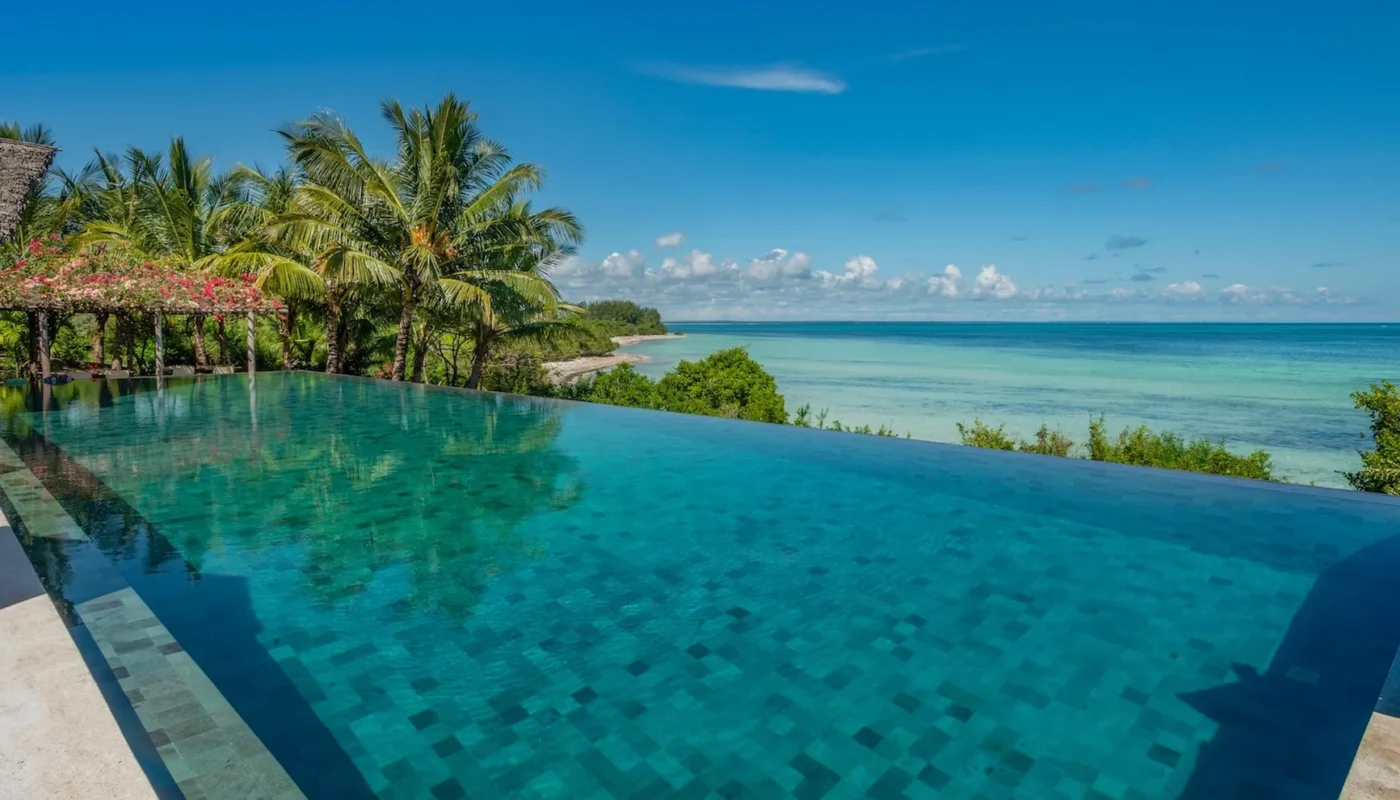Zanzibar, a name that conjures images of white sandy beaches, turquoise waters, and rich cultural history, is an archipelago located off the coast of Tanzania in East Africa. Where is Zanzibar Tanzania: This article will take you on a detailed journey through Zanzibar’s geographical location, historical significance, cultural richness, and its allure as a top tourist destination. By the end of this article, you will have a comprehensive understanding of where Zanzibar is, what makes it unique, and why it’s worth visiting.
1. Introduction to Zanzibar
Zanzibar is not just one island but a collection of islands that form an archipelago in the Indian Ocean. The two main islands are Unguja (commonly referred to as Zanzibar Island) and Pemba, along with several smaller islets. Located approximately 25 to 50 kilometers (16 to 31 miles) off the mainland of Tanzania, Zanzibar is renowned for its stunning beaches, vibrant culture, and rich history.
Subpoint: Geographic Overview
- Zanzibar’s strategic location in the Indian Ocean has made it a melting pot of cultures, influenced by African, Arab, Persian, Indian, and European traders over centuries. The island’s capital, Zanzibar City, is home to the famous Stone Town, a UNESCO World Heritage site.
2. Geographical Location of Zanzibar
Zanzibar is situated off the eastern coast of Africa, in the Indian Ocean, roughly 6 degrees south of the equator. It lies between latitudes 5° and 6° S and longitudes 39° and 40° E. The archipelago is part of Tanzania, although it has its own semi-autonomous government.
Subpoint: Proximity to Mainland Tanzania
- Zanzibar is about 25 to 50 kilometers (16 to 31 miles) from the Tanzanian mainland, with the shortest distance being from Dar es Salaam to Stone Town, the capital of Zanzibar. The ferry ride from Dar es Salaam to Zanzibar takes about 2 hours, while a flight takes around 20 to 30 minutes.
3. Zanzibar’s Place in Africa
Zanzibar’s position in Africa places it at a crossroads of major sea routes, connecting the Middle East, Africa, and Asia. This has significantly influenced its cultural, economic, and historical development.
Subpoint: Historical Significance
- The island has been a key trading hub for centuries, particularly during the era of the Sultanate of Oman when Zanzibar served as the capital. It was a major center for the trade of spices, ivory, and slaves, shaping its identity as the “Spice Island.”
4. The Main Islands of Zanzibar
Zanzibar is composed of two main islands—Unguja and Pemba—each with its own unique characteristics and attractions.
Subpoint: Unguja (Zanzibar Island)
- Unguja, commonly known as Zanzibar Island, is the larger and more populous of the two main islands. It is the cultural and economic heart of Zanzibar, with Stone Town as its historic core. The island is famous for its beautiful beaches, bustling markets, and historical sites.
Subpoint: Pemba Island
- Pemba, the second-largest island, lies to the north of Unguja. Known for its lush green hills, spice farms, and pristine dive sites, Pemba is less developed than Unguja, offering a more tranquil and off-the-beaten-path experience.
5. Climate and Weather in Zanzibar
Zanzibar enjoys a tropical climate, characterized by warm temperatures year-round. However, there are distinct wet and dry seasons that can influence the best times to visit.
Subpoint: The Dry Season
- The dry season, from June to October, is the most popular time to visit Zanzibar. During this period, the weather is warm and sunny, with little to no rainfall, making it ideal for beach activities and exploring the island.
Subpoint: The Wet Season
- The wet season is divided into two periods: the long rains (March to May) and the short rains (November to December). While the island is less crowded during the rainy season, it still offers a lush, green landscape and lower prices.
6. The Cultural Melting Pot of Zanzibar
Zanzibar’s rich cultural heritage is a result of centuries of trade and interaction with various civilizations. The island’s culture is a blend of African, Arab, Persian, Indian, and European influences, reflected in its architecture, cuisine, and traditions.
Subpoint: The Swahili Culture
- The Swahili culture, which dominates the island, is a fusion of Bantu, Arab, and Persian cultures. This is evident in the Swahili language, which is widely spoken, as well as in the island’s traditional music, dance, and art.
Subpoint: Religious Influence
- Islam is the predominant religion in Zanzibar, with the majority of the population being Sunni Muslims. This influence is visible in the island’s architecture, festivals, and daily life, particularly in Stone Town.
7. Stone Town: The Historical Heart of Zanzibar
Stone Town, the historic part of Zanzibar City, is a labyrinth of narrow alleys, bustling markets, and centuries-old buildings. It is a UNESCO World Heritage site, recognized for its unique blend of architectural styles and cultural significance.
Subpoint: Architectural Marvels
- Stone Town’s architecture is a mix of Arab, Persian, Indian, and European styles, with iconic buildings such as the House of Wonders, the Old Fort, and the Sultan’s Palace. The town’s intricately carved wooden doors are particularly famous.
Subpoint: Cultural Attractions
- Visitors to Stone Town can explore its vibrant markets, visit the old slave market site, and learn about the island’s history at various museums. The town also hosts cultural festivals, such as the Zanzibar International Film Festival and Sauti za Busara music festival.
8. Beaches and Natural Beauty of Zanzibar
Zanzibar is renowned for its stunning beaches, crystal-clear waters, and abundant marine life. The island’s coastline is dotted with idyllic beach resorts, each offering its own slice of paradise.
Subpoint: Northern Beaches
- The northern beaches, such as Nungwi and Kendwa, are famous for their powdery white sand and vibrant nightlife. These beaches are also ideal for swimming, snorkeling, and diving.
Subpoint: Eastern and Southern Beaches
- The eastern and southern coasts, including places like Paje and Jambiani, offer a more laid-back atmosphere. These areas are popular for kitesurfing, beachcombing, and experiencing local village life.
9. The Spice Islands: Zanzibar’s Agricultural Heritage
Zanzibar is often referred to as the “Spice Island” due to its long history of spice cultivation. The island’s spice farms produce cloves, nutmeg, cinnamon, and other aromatic spices, which were once as valuable as gold.
Subpoint: Spice Tours
- Visitors to Zanzibar can embark on spice tours, where they can learn about the cultivation of various spices, taste fresh produce, and purchase locally made spice products.
Subpoint: Economic Impact
- The spice trade has played a crucial role in Zanzibar’s economy for centuries. Even today, the island’s spice farms contribute significantly to the livelihoods of many Zanzibaris and remain a key export.
10. Zanzibar’s Unique Wildlife and Marine Life
Zanzibar’s rich biodiversity extends beyond its beaches and spice farms. The island is home to unique wildlife, including the endangered Zanzibar red colobus monkey, and offers some of the best diving and snorkeling spots in the world.
Subpoint: Jozani Forest
- The Jozani Chwaka Bay National Park is the only national park in Zanzibar and is home to the rare Zanzibar red colobus monkey. The forest is a haven for wildlife enthusiasts and offers guided tours through its lush vegetation.
Subpoint: Marine Conservation Areas
- Zanzibar’s surrounding waters are part of several marine conservation areas, such as the Mnemba Atoll and Chumbe Island Coral Park. These areas protect the vibrant coral reefs and marine life, providing excellent opportunities for diving and snorkeling.
11. Zanzibar’s Historical Ties with the Arab World
Zanzibar’s history is deeply intertwined with the Arab world, particularly during the era of the Sultanate of Oman. The Omani influence is still evident in Zanzibar’s culture, architecture, and even in its political history.
Subpoint: The Omani Era
- Zanzibar was once the capital of the Sultanate of Oman, and the sultanate’s rule left a lasting legacy on the island. This period saw the development of the spice trade and the construction of many of Zanzibar’s historic buildings.
Subpoint: Cultural Exchanges
- The Arab influence in Zanzibar led to a rich cultural exchange, particularly in the realms of architecture, language, and religion. This fusion of cultures is what gives Zanzibar its unique identity today.
12. Zanzibar’s Influence in the Indian Ocean Trade Network
For centuries, Zanzibar was a pivotal player in the Indian Ocean trade network, serving as a link between Africa, the Middle East, and Asia. The island’s strategic location made it a key trading hub for spices, ivory, and slaves.
Subpoint: Trade Routes
- The monsoon winds facilitated trade across the Indian Ocean, with Zanzibar serving as a stopover for traders from Arabia, Persia, India, and beyond. This trade brought wealth and cultural diversity to the island.
Subpoint: The Slave Trade
- Zanzibar’s history is also marked by its role in the East African slave trade. The island was one of the largest slave markets in the region, and the remnants of this dark past can still be explored in Stone Town.
13. Zanzibar’s Journey to Independence
Zanzibar’s modern history is shaped by its struggle for independence from colonial powers and its eventual union with Tanganyika to form the United Republic of Tanzania


